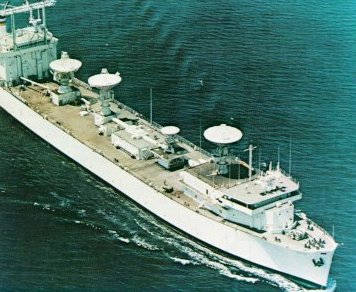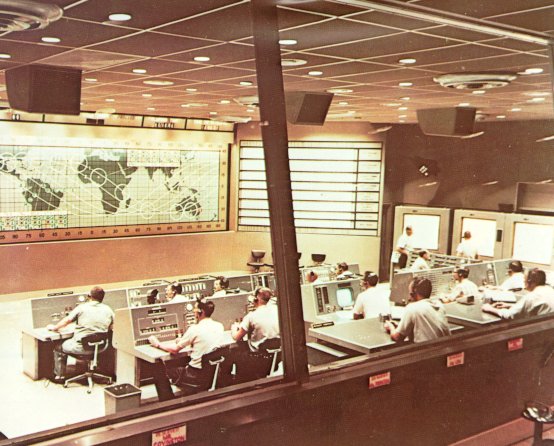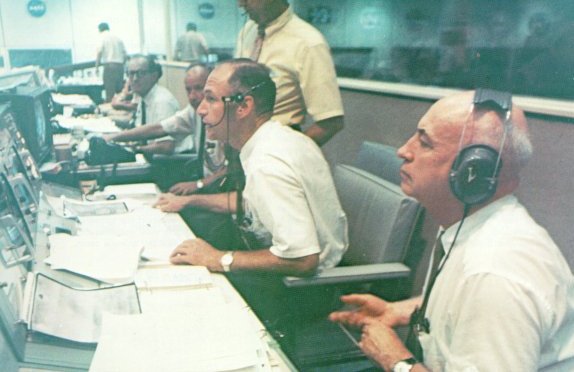Apollo Expeditions to the Moon
AN ADVANCED COMPUTER COMPLEX
As the team was being built, the facilities and equipment were also being
defined, developed, constructed, and brought on line. The Mercury flights were
directed from a control center at Cape Canaveral, Fla. In 1962, the Space Task
Group moved to Houston to form the Manned Spacecraft Center. The construction
of the Mission Control Center in Houston, designed to accomplish the lunar missions,
was started in 1962. Thirty-six months later it was to be used to control Jim McDivitt's
and Ed White's flight in the Gemini IV spacecraft. Its full capability was not used for
Gemini, however, as much work still had to be accomplished. One of the most
advanced computer complexes in the world had to be integrated with a global tracking
network. Tracking and telemetry data had to be relayed from stations in Australia,
Spain, the Canary Islands, Guam, Ascension Island, California, Bermuda, Hawaii,
Tananarive, and Corpus Christi. Tracking ships were built to provide additional
communication coverage in ocean areas. Special Apollo Range and Instrumentation
Aircraft (modified Boeing KC-135 jets) were deployed around the world.
| | |
Resembling a porpoise with its bottle-nosed antenna housing,
this converted KC-135 tanker was one of four Apollo Range
and Instrumentation Aircraft. ARIA supplied voice and telemetry
coverage to the Apollo spacecraft over those parts of the Earth
orbits that were beyond the reach of the ground stations.
|
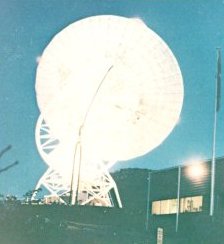
|
The 85-foot paraboloid at the Honeysuckle
tracking station in Australia is one of the three
primary antennas on which MSFN depends for
tracking at lunar distances. All three are located
alongside similar dishes of the Deep Space Network.
This redundancy increased Apollo mission safety.
|
| | |
The tracking ship Vanguard was
positioned, for Apollo launches, in an
area of the Atlantic Ocean where
there are no island stations. It provided
tracking, telemetry, and voice
coverage during the insertion into
Earth orbit, As many as five tracking
ships were employed on the early
Apollo missions.
|
All this was being done concurrently with the evolution of operational concepts.
During the Mercury and Gemini flight programs, teams of flight controllers at the
remote tracking stations were responsible for certain operational duties somewhat
independent of the main Control Center. The advantages of having one centralized
operations team became more apparent, and for Apollo,
two high-speed 2.4-kilobit-per-second
data lines connected each remote site to the Mission Control Center in
Houston. This permitted the centralization of the flight control team in Houston.
Provisions were also made to tie into the Control Center, through a communications
network, the best engineering talent available at contractor and government facilities.
| | |
In Mercury days, with a one-man spacecraft in
Earth orbit, this control center was sufficient.
|
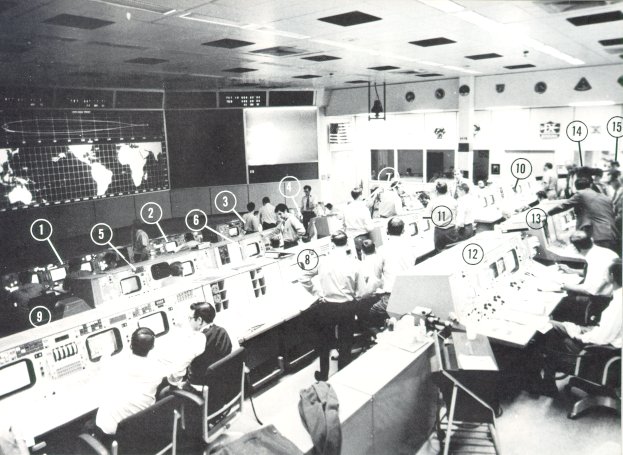
|
| |
By Apollo, with three men in two spacecraft at lunar
distances, Mission Control had grown.
An array of specialists manned the consoles during an Apollo mission.
Key numbers above identify the locations of flight controllers. 1 was
the Booster Systems Engineer, responsible
for the three Saturn stages. 2 was the Retrofire Officer,
keeping continuous track of abort and return-to-Earth options. 3 was
the Flight Dynamics Officer, in charge of monitoring trajectories
and planning major spacecraft maneuvers; he also managed onboard
propulsion systems. 4 was the Guidance Officer, who watched
over the CSM and LM computers and the abort guidance system. In
the second row, 5 was the Flight Surgeon, keeping an eye on the
condition of the flight crew. At 6 was the Spacecraft Communicator,
an Astronaut and member of the support crew, who sent up the
Flight Director's instructions. (He was usually called CapCom, for
Capsule Communicator, from Mercury days.) 7 concerned CSM and
LM systems, including guidance and navigation hardware; and electrical,
environmental, and communications systems. After Apollo 11, all communications
systems were consolidated as a separate task. On the
next row in the middle was 8, the Flight Director, the team leader. 9
was the Operations and Procedures Officer, who kept the team - in and
out of the Center - working together in an integrated way. 10 was
the Network Controller, who coordinated the worldwide communications
links. 11 was the Flight Activities Officer, who kept track of
flight crew activities in relationship to the mission's time line. 12 was
the Public Affairs Officer who served as the radio and TV voice of
Mission Control. 13 was the Director of Flight Operations; 14 the Mission
Director from NASA Headquarters; and 15 the Department of Defense
representative. During activity on the lunar surface an Experiments
Officer manned the console at 1 to direct scientific activities and relay
word from the science team.
|
As engineers from the Goddard Space Flight Center were intently determining
the requirements for this ground communications network, building and installing
equipment, and laboriously testing and verifying the network's capabilities, engineers
in Houston, led by a young Air Force officer, Pete Clements, and a fine young
engineer, Lynwood Dunseith, were feverishly working to integrate the computer complex
and Control Center displays with the network. The critical parameters and limits
that had to be monitored in flight needed to be defined; the necessary sensors for
measuring the parameters needed to be incorporated in the design of the spacecraft;
and rules for utilizing the measurements needed to be developed. But it was not only
a question of ensuring that the right measurements were made. Spacecraft and subsystem
design also had to have the redundancy and the flexibility needed to overcome
failures and contingencies as they arose. And time was relentlessly marching on. Testing of
the spacecraft revealed new problems, and new techniques and procedures
often had to be developed to avoid potential difticulties in flight. Programs had to be
developed for operating the spacecraft and Control Center computers, and the programs
had to be verified, tested, and incorporated in the computers. The end of the
decade moved closer each day. The complexity of the spacecraft and launch vehicle
was exceeded only by the complexity of a worldwide ground-control system.
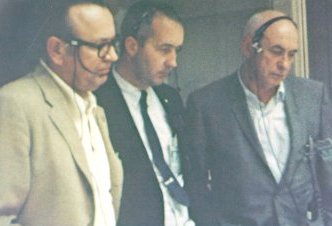
|
Only minutes before this picture was taken, Jack
Swigert had made the call, "Houston, we've had
a problem." Left to right, Christopher C. Kraft,
Jr., Deputy Director of the Manned Spacecraft
Center; James A. McDivitt, Apollo Spacecraft
Program Manager; and Robert R. Gilruth, Director
of the Manned Spacecraft Center.
|
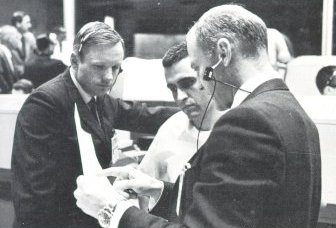
|
Astronauts assigned to an upcoming mission
took particular interest in following the current
flight from the Mission Control Center. In this
picture, taken during the Apollo 10 mission, Neil
Armstrong (left) and Buzz Aldrin (right) discuss
the lunar orbit activities in progress with astronaut-scientist
Jack Schmitt.
|
Then came January 27, 1967, and the AS-204 fire, a day I'll never forget. I was
at the console in Houston monitoring the test at the Cape, together with a group of
flight controllers. We thought we had considered every eventuality, and now we were
struck down by an event that did not occur in space but happened during a ground
test. There were no excuses that could be offered but, out of the despair of the fire,
there came a rededication to the successful accomplishment of the goal and an
intensified effort on the part of every individual.
The Operations Team had many functions not associated with testing and checking
out the spacecraft and controlling the mission. These functions were nevertheless
essential to success. One was recovery operations. Recovery techniques for the spacecraft
and the crew had to be worked out in conjunction with the Department of
Defense and the U.S. Navy. Bob Thompson organized and led this effort during
Mercury and Gemini. The organizational team he established provided the same excellent
recovery support for Apollo as it had for Mercury and Gemini.
| | |
A long moment of quiet satisfaction in the Mission
Operations Control Room during the Apollo
11 mission, as George Low and Robert Gilruth
look past their consoles toward a television monitor
where they can watch astronauts Armstrong
and Aldrin walking on the Moon.
|
|



